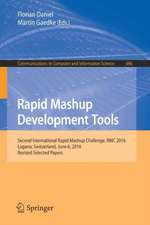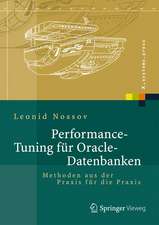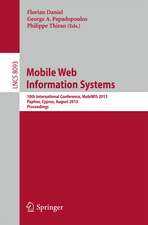Mashups: Concepts, Models and Architectures: Data-Centric Systems and Applications
Autor Florian Daniel, Maristella Materaen Limba Engleză Paperback – 22 sep 2016
Daniel and Matera have written the first comprehensive reference work for mashups. They systematically cover the main concepts and techniques underlying mashup design and development, the synergies among the models involved at different levels of abstraction and the way models materialize into composition paradigms and architectures of corresponding development tools. The book deliberately takes a balanced approach, combining a scientific perspective on the topic with an in-depth view on relevant technologies.
To this end, the first part of the book introduces the theoretical and technological foundations for designing and developing mashups, as well as for designing tools that can aid mashup development. The second part then focuses more specifically on various aspects of mashups. It discusses a set of core component technologies, core approaches and architectural patterns, with a particular emphasis on tool-aided mashup development exploiting model-driven architectures. Development processes for mashups are also discussed and special attention is paid to composition paradigms for the end-user development of mashups and quality issues.
Overall, the book is of interest to a wide range of readers. Students, lecturers, and researchers will find a comprehensive overview of core concepts and technological foundations for mashup implementation and composition. Even without low-level coding details, practitioners like software architects will find guidance on key implementation concepts, architectural patterns and development tools and approaches. A related website provides additional teaching material which can be used either as part of a course or for self study.
| Toate formatele și edițiile | Preț | Express |
|---|---|---|
| Paperback (1) | 334.53 lei 6-8 săpt. | |
| Springer Berlin, Heidelberg – 22 sep 2016 | 334.53 lei 6-8 săpt. | |
| Hardback (1) | 321.70 lei 38-44 zile | |
| Springer Berlin, Heidelberg – 22 aug 2014 | 321.70 lei 38-44 zile |
Din seria Data-Centric Systems and Applications
- 20%
 Preț: 777.07 lei
Preț: 777.07 lei - 20%
 Preț: 430.26 lei
Preț: 430.26 lei - 20%
 Preț: 340.34 lei
Preț: 340.34 lei - 20%
 Preț: 337.91 lei
Preț: 337.91 lei - 20%
 Preț: 499.23 lei
Preț: 499.23 lei - 20%
 Preț: 1062.89 lei
Preț: 1062.89 lei - 20%
 Preț: 344.76 lei
Preț: 344.76 lei - 20%
 Preț: 663.61 lei
Preț: 663.61 lei - 20%
 Preț: 607.51 lei
Preț: 607.51 lei - 20%
 Preț: 347.74 lei
Preț: 347.74 lei - 20%
 Preț: 512.72 lei
Preț: 512.72 lei - 20%
 Preț: 339.14 lei
Preț: 339.14 lei - 20%
 Preț: 698.57 lei
Preț: 698.57 lei - 20%
 Preț: 650.27 lei
Preț: 650.27 lei - 20%
 Preț: 375.69 lei
Preț: 375.69 lei - 20%
 Preț: 420.84 lei
Preț: 420.84 lei - 20%
 Preț: 479.30 lei
Preț: 479.30 lei - 20%
 Preț: 321.70 lei
Preț: 321.70 lei - 20%
 Preț: 726.16 lei
Preț: 726.16 lei - 20%
 Preț: 333.50 lei
Preț: 333.50 lei - 20%
 Preț: 834.36 lei
Preț: 834.36 lei - 20%
 Preț: 333.88 lei
Preț: 333.88 lei - 20%
 Preț: 520.82 lei
Preț: 520.82 lei
Preț: 334.53 lei
Preț vechi: 418.16 lei
-20% Nou
Puncte Express: 502
Preț estimativ în valută:
64.02€ • 66.59$ • 52.85£
64.02€ • 66.59$ • 52.85£
Carte tipărită la comandă
Livrare economică 15-29 aprilie
Preluare comenzi: 021 569.72.76
Specificații
ISBN-13: 9783662509593
ISBN-10: 3662509598
Pagini: 338
Ilustrații: XIX, 319 p. 119 illus., 2 illus. in color.
Dimensiuni: 155 x 235 x 18 mm
Greutate: 0.48 kg
Ediția:Softcover reprint of the original 1st ed. 2014
Editura: Springer Berlin, Heidelberg
Colecția Springer
Seria Data-Centric Systems and Applications
Locul publicării:Berlin, Heidelberg, Germany
ISBN-10: 3662509598
Pagini: 338
Ilustrații: XIX, 319 p. 119 illus., 2 illus. in color.
Dimensiuni: 155 x 235 x 18 mm
Greutate: 0.48 kg
Ediția:Softcover reprint of the original 1st ed. 2014
Editura: Springer Berlin, Heidelberg
Colecția Springer
Seria Data-Centric Systems and Applications
Locul publicării:Berlin, Heidelberg, Germany
Cuprins
1 Introduction.- Part I Fundamentals.- 2 Data and Application Integration.- 3 Web Technologies.- 4 Model-Driven Software Development.- Part II Mashups.- 5 Mashup Components.- 6 Mashups.- 7 Advanced Mashups.- 8 Tool-Aided Mashup Development.- 9 Mashups and End-User Development.- 10 Quality in Mashup Development.- 11 Outlook.
Notă biografică
Florian Daniel is a senior research fellow at the University of Trento, Italy. He has been visiting researcher at UNSW, Sydney, Australia, and HP Labs, Palo Alto, USA, and post-doc researcher at Politecnico di Milano, Italy. Florian has been working on mashups and lightweight integration on the Web for more than seven years in the context of own research, EU-FP7 projects, and industry-funded projects in Europe, the United States and China. His research interests also include conceptual modeling of Web applications, business process management and service-oriented computing. Florian has served as PC Chair of the international conferences BPM, ICWE and MobiWIS.
Maristella Matera is Associate Professor at Politecnico di Milano. Her research focuses on Web engineering, with particular emphasis on model-based methods and tools for Web application development. She dedicated the last years to investigating mashup languages and tools, with particular focus on the definition of composition paradigms for end-user development. She worked on these (and other) research topics in the context of several national and international research projects. She published the achieved results in more than one hundred papers and in the books "Engineering Web Applications" (Springer, 2009) and "Designing Data-Intensive Web Applications" (Morgan Kaufmann publisher, 2002).
Maristella Matera is Associate Professor at Politecnico di Milano. Her research focuses on Web engineering, with particular emphasis on model-based methods and tools for Web application development. She dedicated the last years to investigating mashup languages and tools, with particular focus on the definition of composition paradigms for end-user development. She worked on these (and other) research topics in the context of several national and international research projects. She published the achieved results in more than one hundred papers and in the books "Engineering Web Applications" (Springer, 2009) and "Designing Data-Intensive Web Applications" (Morgan Kaufmann publisher, 2002).
Textul de pe ultima copertă
Mashups have emerged as an innovative software trend that re-interprets existing Web building blocks and leverages the composition of individual components in novel, value-adding ways. Additional appeal also derives from their potential to turn non-programmers into developers.
Daniel and Matera have written the first comprehensive reference work for mashups. They systematically cover the main concepts and techniques underlying mashup design and development, the synergies among the models involved at different levels of abstraction, and the way models materialize into composition paradigms and architectures of corresponding development tools. The book deliberately takes a balanced approach, combining a scientific perspective on the topic with an in-depth view on relevant technologies.
To this end, the first part of the book introduces the theoretical and technological foundations for designing and developing mashups, as well as for designing tools that can aid mashup development. The second part then focuses more specifically on various aspects of mashups. It discusses a set of core component technologies, core approaches, and architectural patterns, with a particular emphasis on tool-aided mashup development exploiting model-driven architectures. Development processes for mashups are also discussed, and special attention is paid to composition paradigms for the end-user development of mashups and quality issues.
Overall, the book is of interest to a wide range of readers. Students, lecturers, and researchers will find a comprehensive overview of core concepts and technological foundations for mashup implementation and composition. Even without low-level coding details, practitioners like software architects will find guidance on key implementation concepts, architectural patterns, and development tools and approaches. A related website provides additional teaching material which can be used either as part of a course or for self study.
Daniel and Matera have written the first comprehensive reference work for mashups. They systematically cover the main concepts and techniques underlying mashup design and development, the synergies among the models involved at different levels of abstraction, and the way models materialize into composition paradigms and architectures of corresponding development tools. The book deliberately takes a balanced approach, combining a scientific perspective on the topic with an in-depth view on relevant technologies.
To this end, the first part of the book introduces the theoretical and technological foundations for designing and developing mashups, as well as for designing tools that can aid mashup development. The second part then focuses more specifically on various aspects of mashups. It discusses a set of core component technologies, core approaches, and architectural patterns, with a particular emphasis on tool-aided mashup development exploiting model-driven architectures. Development processes for mashups are also discussed, and special attention is paid to composition paradigms for the end-user development of mashups and quality issues.
Overall, the book is of interest to a wide range of readers. Students, lecturers, and researchers will find a comprehensive overview of core concepts and technological foundations for mashup implementation and composition. Even without low-level coding details, practitioners like software architects will find guidance on key implementation concepts, architectural patterns, and development tools and approaches. A related website provides additional teaching material which can be used either as part of a course or for self study.
Caracteristici
First comprehensive overview of core concepts, basic technologies and architectural patterns related to mashup development Combines a scientific perspective with an in-depth treatment of relevant technologies Complemented by a web site providing additional teaching materials and a discussion forum Includes supplementary material: sn.pub/extras


























